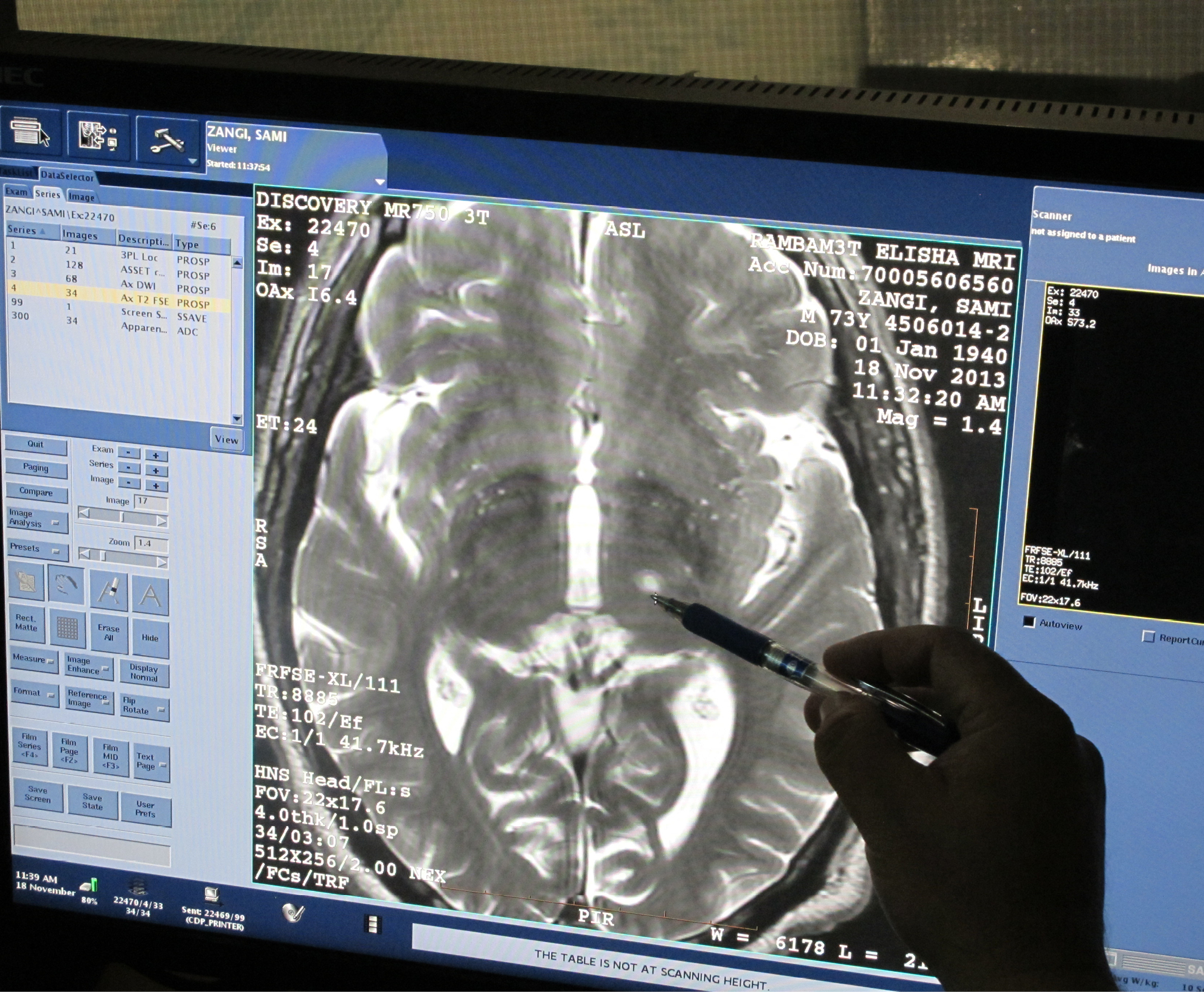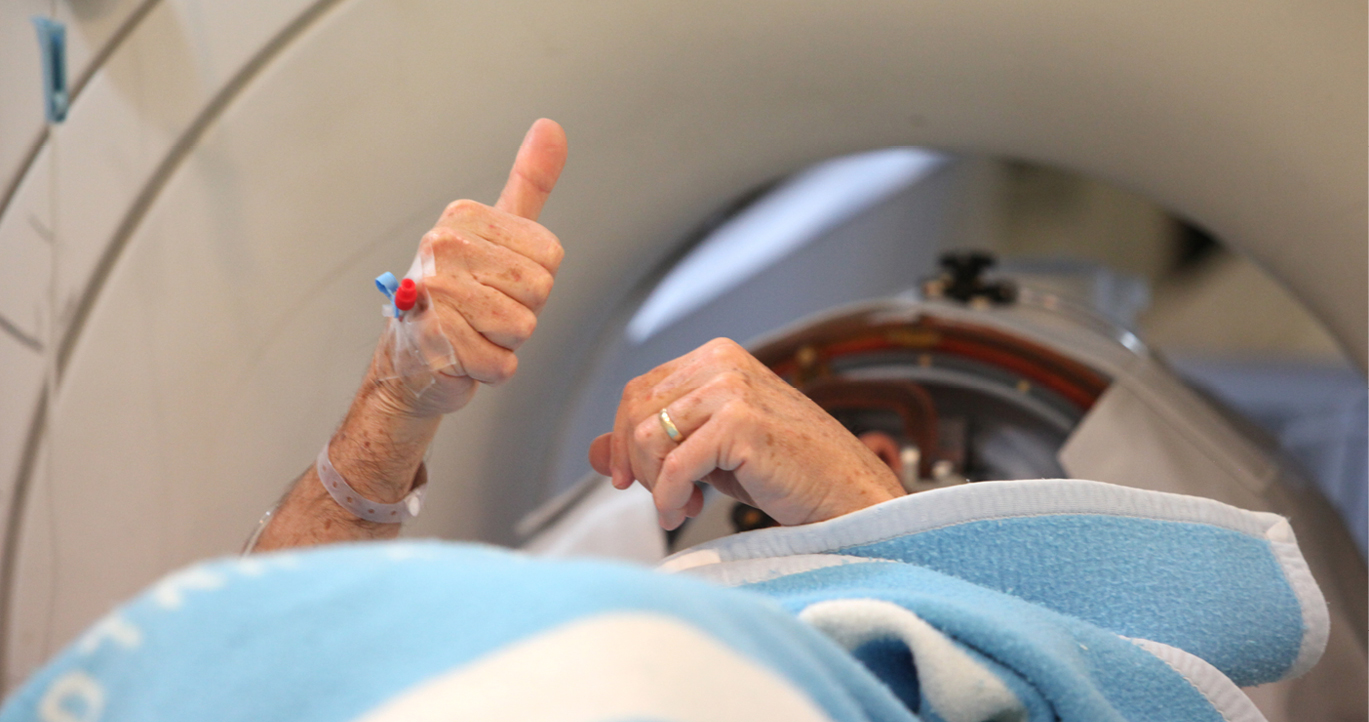Curing the Shakes
By Lynn Wexler
VEGASMD

“My tremors are gone,” said Rabbi Yocheved Mintz, following a recent four-hour MRI-guided Focused Ultrasound procedure (FUS) performed by a team of neurology experts at the Rambam Medical Center in Haifa, Israel. The recently retired 78-year-old spiritual leader (now Rabbi Emerita) at Congregation P’nai Tikvah in Las Vegas was diagnosed with Parkinson’s Disease in 2013 by doctors at the Cleveland Clinic Lou Ruvo Center for Brain Health.
“While the diagnosis was life altering, so are the results of this procedure. My quality of life has been significantly restored. The shaking in my right hand and leg was debilitating and, frankly, embarrassing. I can’t thank the Rambam medical team enough!” beams Mintz.
Dr. Ilana Schlesinger is a Rambam senior neurologist and heads the Movement Disorders and Parkinson’s Center there. She also led the team that performed the Focused Ultrasound on Mintz.
“Parkinson’s is a neurodegenerative disorder, characterized by tremors, muscle rigidity, bradykinesia (slowness of movement), and impaired balance and coordination. Tremors are the most common initial symptom of Parkinson’s Disease and observed in about 50% of patients at the time of diagnosis,” Schlesinger says.
The disease is named for British physician James Parkinson who, in 1817, published the first description of the disease in an article entitled An Essay on the Shaking Palsy. The cause is unknown but believed to involve both genetic and environmental factors. It is associated with degeneration of vital nerve cells in the brain (neurons), coupled with a deficiency of the neurotransmitter dopamine, a chemical essential for the control of movement and coordination. There is currently no cure. The Rambam Medical Center, though, was the first medical center in Israel to offer the breakthrough procedure, treating tremors in both Parkinson’s and Essential Tremor (a nerve disorder characterized by uncontrollable shaking).
FUS technology, developed by the Israeli company InSightec, enables noninvasive MRI-guided ultrasound to ablate (destroy) affected tissue by concentrating beams through the skull to heat the target area. FUS offers an alternative to the surgically invasive Deep Brain Stimulation (FDA approved in the U.S. to treat Parkinson’s and Essential Tremor patients) where electrodes are implanted in the brain itself.
“This ability to treat a problem inside the brain without penetrating the skull is a breakthrough. We’re able to see and treat the area from the outside, without having to surgically enter the brain,” explains Schlesinger.
The procedure requires a team of four specialists: a movement disorder neurologist (Schlesinger), a neurosurgeon, a neuro-radiologist, and an anesthesiologist, “all of who must work precisely together since the results are irreversible.” The procedure isn’t without risks, however. “We can safely use the technology to treat only one side of the brain,” Schlesinger continues. “Bilateral lesions using this procedure run the risk of causing loss of speech and swallowing.”
Each of the fifty-eight patients Rambam’s neurological team has treated since 2013 have been medication resistant. Of those, 80% have had no tremor reoccurrence, while 20% have seen a minimal return. Only one patient saw tremors return with the same intensity. The results are encouraging. “We expect to apply this technology to treat Parkinson’s, not just the tremors, in the near future,” says Schlesinger.
Mintz describes her journey from diagnosis to cured tremors as having amazing moments of bashert (Yiddish for inevitable or preordained) and miracles. “I had no idea that my trip to Israel would have me undergoing a treatment, let alone returning tremor free,” says Mintz.
The trip, planned as a three-week tour of Israeli organizations, from various fields, working on life-saving initiatives, was organized by Rabbi Liat Yardeni-Funk, an old friend of Mintz’s, for students and board members of the Academy for Jewish Religion-CA (AJRCA) – where Mintz received her rabbinic ordination. Yardeni-Funk, the Dean of the Rabbinical School of AJRCA, also organized a special surprise for Mintz.
“One of the stops on the tour was the Rambam Medical Center,” says Mintz. “The hospital is extraordinary in many respects, but I was excited at the time to visit its three-story, underground, full service medical facility.” That facility, which normally serves as a parking structure, can, within 72 hours, convert to a 2000 bed hospital, is sealed from chemical warfare in the event of missile attacks from neighboring hostile countries. Mintz would also become aware of the center’s success in treating Parkinson’s tremors.
With the help of Sari Katz Arshadnia, the Los Angeles-based Director, Western Region, for the American Friends of Rambam, Yardeni-Funk got Rambam’s representative to agree, during the tour, to mention to the group the work they were doing to cure tremors. The hope was that Mintz would jump at the opportunity to inquire further.
“That hope was realized. The rest is history!” exclaimed Yardeni-Funk.
“I was honored to have been there when the shidduch (matchmaking) was made between Rabbi Mintz and the Parkinson’s Center,” shared Katz Arshadnia, whose fundraising efforts help to enable the center’s growth and success.
Dr. Zoltan Mari, MD, is Mintz’s treating physician in Las Vegas and, since this past May, the Section Head of the Nevada Movement Disorders Program and Lee Pascal Parkinson’s Disease Scholar at Cleveland Clinic Lou Ruvo Center for Brain Health. Mari, Schlesinger, and another member of the Rambam neurology team had all previously been colleagues at Johns Hopkins Hospital-Neurology in Baltimore, Maryland.
Even with the past professional relationship, Mari, like Mintz, was unaware a plan was in the works for Mintz to possibly be treated for her tremors while in Israel. He notes that, in this instance, the sharing of medical records and advance preparation and coordination between the Ruvo Clinic and Rambam was not necessary.
“They (the Rambam neurology team) can easily confirm a diagnosis via a medical exam, a patient’s narrative, and the effectiveness of medications to determine if someone is a candidate for FUS, which Rabbi Mintz clearly was,” Mari said.
Mintz described the treatment as pain free and “like being in a Chagall painting.” Comfortable, for the most part, and somewhat like floating on air. She was wide awake and under no sedation. Doctors intermittently removed her from the MRI to monitor her progress. When heat from the beams became uncomfortable, doctors would dial down the intensity. By the end of the treatment, her tremors were gone.
Mari has seen the results from a handful of patients treated at Johns Hopkins by FUS for Essential Tremors. “The results were remarkable (60 to 70% improvement), but Rabbi Mintz’s results, at 100%, surpass anything I have seen thus far.” He explained, though, that it’s too soon to determine the reason for this, suggesting it could be partially attributed to the aggressive versus conservative approach of the team performing the procedure.
“Once the right coordinates on the brain are determined, and the heat from the ultrasound beam is applied and the tremor responds successfully, the technicians decide to what extent they will increase the energy to further destroy the tissue causing the tremor,” Mari explains. “The possibility of transient side effects is considered. Some technicians would prefer to accept a conservative resolution rather than risk damage from attempting 100% resolution.”
The Ruvo Clinic does not currently offer FUS treatment, but expects to have the pioneering technology they are working on to be approved by the FDA later this year. Qualified tremor patients instead undergo Deep Brain Stimulation, the results of which, according to Mari, seem to last longer than FUS, “but the data is too recent to draw a reliable conclusion,” he says.
“DBS, while surgically invasive, also offers the benefit of treating tremors on both sides of the brain; plus the results are reversible and can be adjusted over time according to patient need,” Mari adds. “Patients, in consultation with their doctor, have to decide which is the preferable way to go.”
Marveling at what Mintz calls Nes Gadol Haya Sham (A Great Miracle Happened Here - referring to the miracle of Chanukah), she shares a profound moment the night before she was to undergo the treatment. “I was in Tel Aviv at the annual Laila Lavan (White Night) celebration. Shops and restaurants stay open and the streets are alive with music and dancing ‘til morning,” she says. “Standing at the corner of Ben Gurion and Ben Yehuda – a large scarf artfully wrapped around my head to disguise my baldness [a shaved head is required for the procedure], I was intrigued by a swing band and their professional dancers,” she continues. “Aware that the procedure comes with risks, I thought, what if I will never be able to dance again?”
She summoned the courage to explain her circumstance and ask one of the young men to dance the jitterbug with her. “Turned out that he was certified in dance therapy for Parkinson’s patients! Go figure! I was able to dance half of the song! I knew then that I was ready for the treatment,” said Mintz.
The morning following the procedure, Mintz enjoyed a bitter-sweet breakfast which she related to Yardeni-Funk. For the first time in four years she was able to eat with a fork in her right hand.
“I had Israeli salad this morning, and it tasted terrible,” Mintz told Yardeni Funk.
“How can you say that?” Yardeni-Funk replied. “Israeli salad is delicious!”
“My salad was too salty,” Mintz explained, “because it was covered with my tears.”
For information on the Rambam Medical Center, contact Sari Arshadnia at SArshadnia@aforam.org. For information on the Israel Experience through the Academy of Jewish Religion-CA contact Rabbi Liat Yardeni-Funk at lfunk@ajrca.edu. For information on Parkinson’s treatment at the Cleveland Clinic Lou Ruvo Center for Brain Health contact MacKenzie Ruta at mruta@kirvindoak.com.


